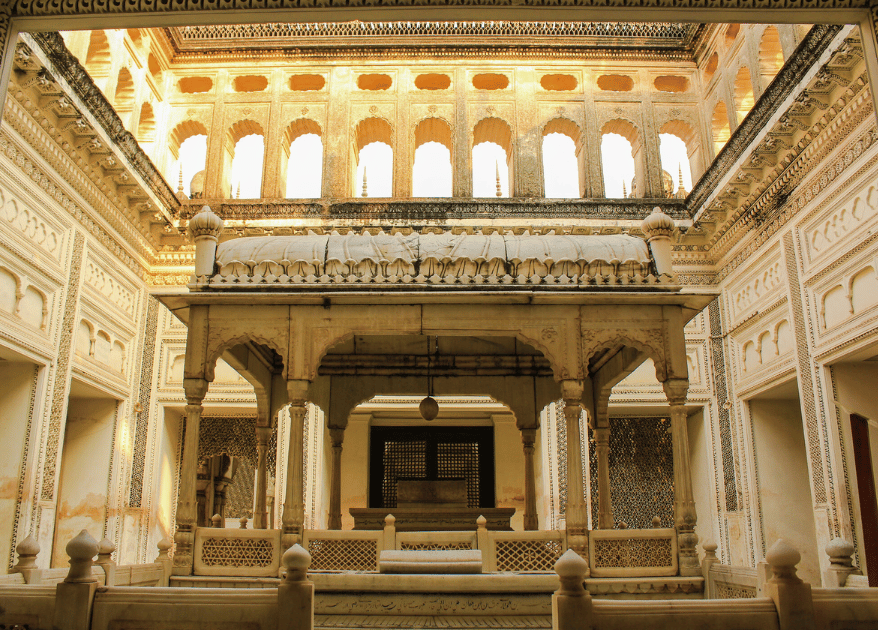BlogHistorical MonumentsLost in Time: Rediscovering th...
Lost in Time: Rediscovering the Splendor of Paigah Tombs in Hyderabad
Hyderabad, a city known for its rich history and architectural wonders, is home to the magnificent Paigah Tombs. These grand structures, steeped in history, stand as a testament to the glorious past of the Paigah nobles. Lost in time, the Paigah Tombs offer a splendid journey through Hyderabad's regal heritage and architectural brilliance. Let us embark on a rediscovery of the splendor of Paigah Tombs and unveil the tales they hold.
Table of Contents
ToggleThe Noble Legacy: Stories of the Paigah Family
Behind the grandeur of the tombs lies a fascinating history of the Paigah family. Known for their loyalty and service to the Nizams, the Paigah nobles played a crucial role in shaping the destiny of Hyderabad. Each tomb holds the stories of the noble souls who once walked these lands, leaving a lasting imprint on the city's heritage and culture.
The Paigah family
The Paigah family, also known as the Shamsheer-ul-Umrahs, consisted of several renowned members who played significant roles in the history of Hyderabad. Here are a few notable members of the Paigah family along with their lifespan:
Nawab Sir Khursheed Jah Bahadur (1846-1911): He served as the Prime Minister of Hyderabad State and was known for his administrative skills and progressive reforms.
Nawab Sir Vicar-ul-Umrah Bahadur (1856-1911): He was a distinguished statesman and diplomat who held several high-ranking positions in the Hyderabad administration.
Nawab Sir Turab-ul-Umrah Bahadur (1865-1936): He was an eminent philanthropist and contributed significantly to the educational and healthcare sectors in Hyderabad.
Nawab Sir Fazal Jung Bahadur (1872-1948): He was a prominent diplomat and served as the Prime Minister of Hyderabad State, making significant contributions to the state’s governance and international relations.
Nawab Sir Umdat-ul-Umrah Bahadur (1873-1936): He was a renowned patron of art and culture and played a crucial role in promoting and preserving the cultural heritage of Hyderabad.
Historical Significance
In the heart of Hyderabad, the Paigah Tombs hold immense historical significance. They were constructed to serve as the final resting place for the Paigah nobles, who were influential figures during the reign of the Nizams. The tombs not only honor the memory of these noble souls but also offer a glimpse into the opulence and grandeur of the bygone era.
Architectural Marvels: Unveiling the Splendor
The Paigah Tombs are architectural marvels that exhibit a fusion of various styles, including Indo-Islamic and European influences. The intricate carvings, ornate domes, and delicate motifs showcase the exemplary craftsmanship of the artisans of that time. As you wander through the tombs, you'll be mesmerized by the symphony of artistry and beauty that adorns every structure.
Lost in Time: Preserving the Heritage
Over the years, the Paigah Tombs faced the challenges of time and neglect. However, efforts have been made to restore and preserve these architectural gems. Restoration projects have breathed new life into the tombs, allowing visitors to experience the glory of the Paigah era and witness the splendor that was once obscured by the passage of time.
Exploring the Tombs: Must-Visit Attractions
A visit to the Paigah Tombs takes you on a captivating journey through history. Within the complex, you'll encounter various tombs and structures, each with its unique architectural style and significance. The Maqhbara Shams al-Umara, Maqhbara Asman Jah, and Maqhbara Iqbal-ud-Daula are among the must-visit attractions that showcase the magnificence of the Paigah Tombs.
Cultural Significance: Festivals and Events
These architectural gems provide a venue for cultural celebrations and events. Festivals like Eid and other cultural programs are organized here, bringing the tombs to life with vibrant colors, traditional music, and dance performances. These events offer visitors an opportunity to immerse themselves in the rich cultural heritage of Hyderabad.
Getting There and Practical Information
One can reach the location by various modes of transportation, including taxis, auto-rickshaws, or private vehicles. The tombs are open to visitors during specific hours, and it's advisable to check the timings beforehand. Visitors should also respect the sanctity of the place and follow any guidelines or rules provided on-site.
Conclusion
As we conclude our journey through the splendor of Paigah Tombs, we leave with a newfound appreciation for the rich history and architectural brilliance they hold. These majestic structures, lost in time yet rediscovered, transport us to an era of grandeur and noble legacies. A visit to the Paigah Tombs is not just a tour but a testament to the enduring heritage of Hyderabad.
FAQs (Frequently Asked Questions)
No, entry to the Paigah Tombs is free for visitors.
Yes, photography is generally allowed inside. However, it’s advisable to check for any specific guidelines or restrictions.
While guided tours may not be available within the complex, there are informative plaques and signage to provide historical insights during your visit.
Limited parking facilities are available near the Paigah Tombs. It’s recommended to plan your visit accordingly and arrive early to secure parking.
It’s advisable to avoid bringing food and drinks inside the complex to maintain cleanliness and respect the sanctity of the place.
Yes, guided tours are available, offering insightful information about the history, architecture, and significance of the tombs.
Special events, cultural performances, and exhibitions are occasionally organized at Paigah Tombs, providing visitors with an opportunity to experience the vibrant cultural heritage of Hyderabad.
Yes, Paigah Tombs are located in close proximity to other popular attractions, including the iconic Charminar, Golconda Fort, and Chowmahalla Palace, making it convenient for visitors to explore multiple landmarks in a single trip.


Add a Comment